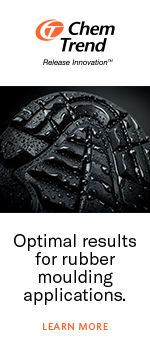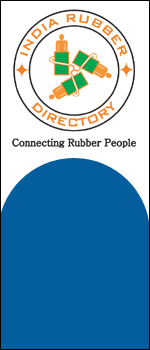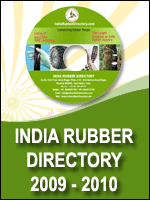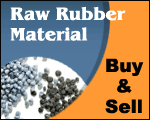Challenges of Sustainability and Environment Protection
In Rubber Industry
Dr. M. C. Badarinarayana
Vice-President, Bayer (India) Ltd, E-mail
mcbadari@vsnl.com
Introdution
Last year a leading automobile tyre manufacturer had to effect recall of tyres
in huge numbers in the light of poor safety in use. The elaborate Quality
management system of the automobile giants in legendary. This in turn has
brought outstanding improvements in quality management systems among its
constituent supply chain. Have you heard matching concern for environmental
aspects, impacts and any voluntary initiatives. Perhaps not Public outcry and
regulatory compulsions have of course brought dramatic improvements in emission
norms. In the background there are also stalwarts with laudable vision, mission
and credo to make vehicles causing no damage to the larger vehicle namely the
planet eath. Their challenge is directly linked t key supplier like. Petroleum
refiners and tyre industry or more broadly the Rubber and its auxiliary
industries.
Environmental aspects
Let us look at how the rubber industry fares in respect of Environment’. Growing
Popularity of ISO14001 has given rise to sufficient awareness about
Environmental Management System (EMS). Rubber industry in its journey from latex
to the hightly engineered finished product Tyre uses a large number of
chemicals. Textiles, metals and substantial utilities of different kinds.
Various unit operations and processes are involved. The resource and energy
intensity persist throughout the life cycle. Extraction, Raw material,
manufacture, testing, use and disposal after use. Here is a fit case for ‘Dfe’ –
Design for Environment program. Design for the Environment (DfE) Programme
provides guidance and tools to help companies ;achieve continuous environmental
improvement. The DfE approach encourages companies to consider environmental and
human health risks in all business decision. In addition, it encourages
companies to evaluate cleaner processes technologies, and workplace practices.
By implementing a DfE-based EMS, the manufacturer can realize many benefits.
Reduction in use of toxic chemicals, raised production, increase employment, and
realize annual cost savings.
For example, A rubber processor rated trichloroethylene (TCE) emissions as
significant environmental aspect for three main reasons; hazardous waste
disposal costs, TCE’s impact on human health, and TCE’s toxicity rating (IARC
listed it as a potential Carcinogen). Since TCE emissions were identified as a
significant aspect, it set an objective to minimize TCE by the end of the fiscal
year. The first step toward reaching the target was to identify where the TCE
was used. The Company incorporated a two-Step aqueous cleaner to replace TCE. As
a result of these efforts, the degreasers have been shut down. Due to the
elimination of TCE in the facility, the company saves approximately $100,000
annually. More importantly, the company has reduced risk by eliminating the use
of a suspected carcinogen in the workplace.
Encouraged by the DfE EMS to find alternative processes, the more efficient
process that dips the metal parts in a vat of adhesives and then spins them in a
centrifuge. Management, along discovered that the new process worked just as
well and also eliminated the excess spray of the adhesive would save the company
money in reduced labour and less adhesive cut the health risk to workers.
Respecting the environment and preserving the health and safety of all the
people who can be in contact with the product from its production stage to its
final use, has always been one of the main objectives of progressive industries.
For the substances that are needed to used in the production of rubber products
such as gloves, shoe soles, boots, hoses or tyres, guarantees of health and
safety have been acquired for the producer and the consumer. Safe use of a
rubber product should also be guaranteed throughout the product’s life.
Another key aspect, which is also seriously taken into account by the rubber
industry, is the environmentally friendly disposal of used rubber products.
Indeed, depending on the product, several additional “lives” may be expected,
although it may be no longer useful in its first application.
Amongst the different solutions proposed, recycling appears to be one of the
best solutions in terms of environmental benefits. This viewpoint is shared by
many industries and all products should not be manufactured taking into account
the recycling step that should follow their use stage.
The tyre companies have recognized their responsibility for the assessment and
improvement of the environmental aspects over the full life cycle (product
stewardship), and the need to inform stakeholders, policymakers and the public
at large about the environmental aspect of tyres. For this purpose, they have
agreed on a common methodology in order to better understand and assess the
possibilities for improving tyre design and the tyre manufacturing, use and
disposal or reuse processes. The LCA is being performed on an average passenger
car tyre.
It is believed that the average tyre will be representative of the reality,
because the tyre is a mature product and the differences amongst the different
manufacturers are not so significant from an environmental point of view.
Large quantities of effluents (Process waste) emanate in the processing of
rubber. In the earlier years, these effluents used to be discharged
indiscriminately into waterways. In the 1970’s biological treatment of effluent
(through anaerobic and aerobic digestion) was developed. The treatment of
effluents before discharge is now an accepted practice and is governed by clear
guidelines from the Department of Environment. At times the effluent is recycled
and used as source of nutrients for crops.
Apart from VOC emission, polluted effluent other environment degrading aspects
are particulates, hazardous solid waste, noise. Resource intensity especially
energy ranges from substantial for Natural rubber to very high for synthetic
rubber. Recyclability is relatively more difficult for elastomers compared to
thermoplastics. Energy recovery by incineration and raw material recovery
through pyrolysis are some of the redeeming aspects. In our country retreading
and better for sustainability. Smell and allergy are also among the negative
aspects of the industry requiring attention and remedial action.
When it comes to synthetic rubber a lot more measures are required to accomplish
low level of risk to persons and environment. In the case of polybutadiene the
monomer butadiene is flammable, reactive and vulnerable for accidental release.
(Storage under pressure and refrigeration).
Conclusion
Rubber industry be it natural rubber processing or synthetic one has major
environment impacting potential. A sound Environment Management Program has to
be formulated and implemented to prevent irreversible damage. This is applicable
at all stages of cradle to grave. Fortunately there is sufficient awareness in
this field and improvements are taking place. However a lot more needs to be
done by the end user especially automotive sector.
Acknowledgement
Following literature has been freely used in the development of this paper.
1. The European Tyre industry Recycling Association (ETRA) interview with Dr.
Valerie L Shulman, Secretary General, UTA International Edition-Technology &
Environment 3rd issue p. 136, Dec. 2/1996.
2. Waste tires fuel UK cement facility;, worldwide Waste Management P. 6, Nov.
1999.
3. EPA Risk management Plan 8153 Ohio-Firestone Synthetic Rubber Latex Co. Pilot
Plant, Akron, Aug. 24, 1999.
4. UK Environmental Protection Expenditure Survey, SIC25TGN Plastics & Rubber
Industry Sept. 21, 2000.
5. The Recycling in Europe Dianne Sarrcini, North American Recycled Rubber
Association.
6. Report and Summary of discussions ICEM world Conference for the Rubber
Industries, kaula Lumpur, Malaysia, June 25-26. 1998.
7. Rubber and the Environment by Kevin P. Jones IRRD Board.
*Paper Presented at the International Seminar Organised by AIRIA and Capexil at
Nehru Centre, Mumbai during April 3rd to 5th, 2001.


























